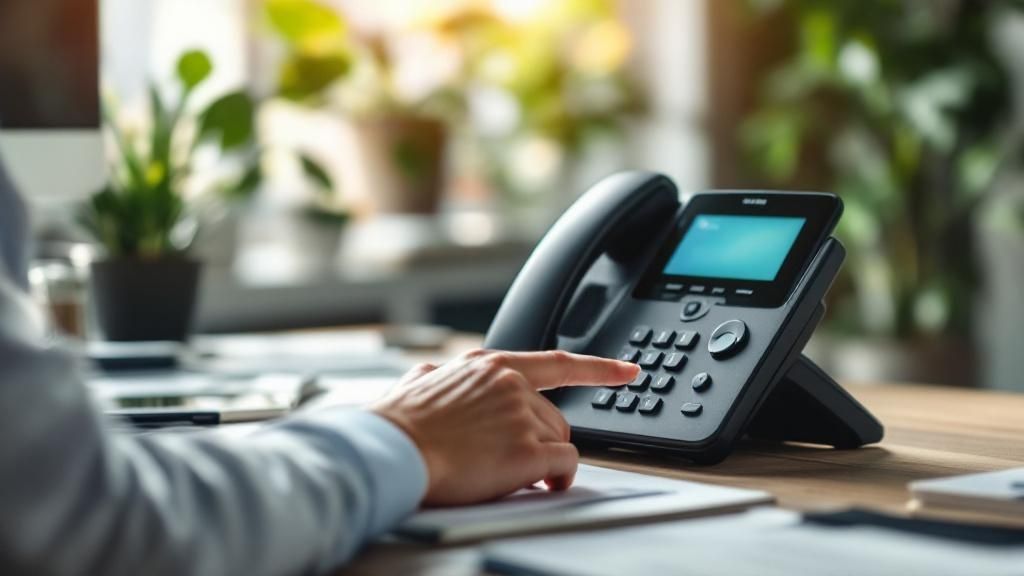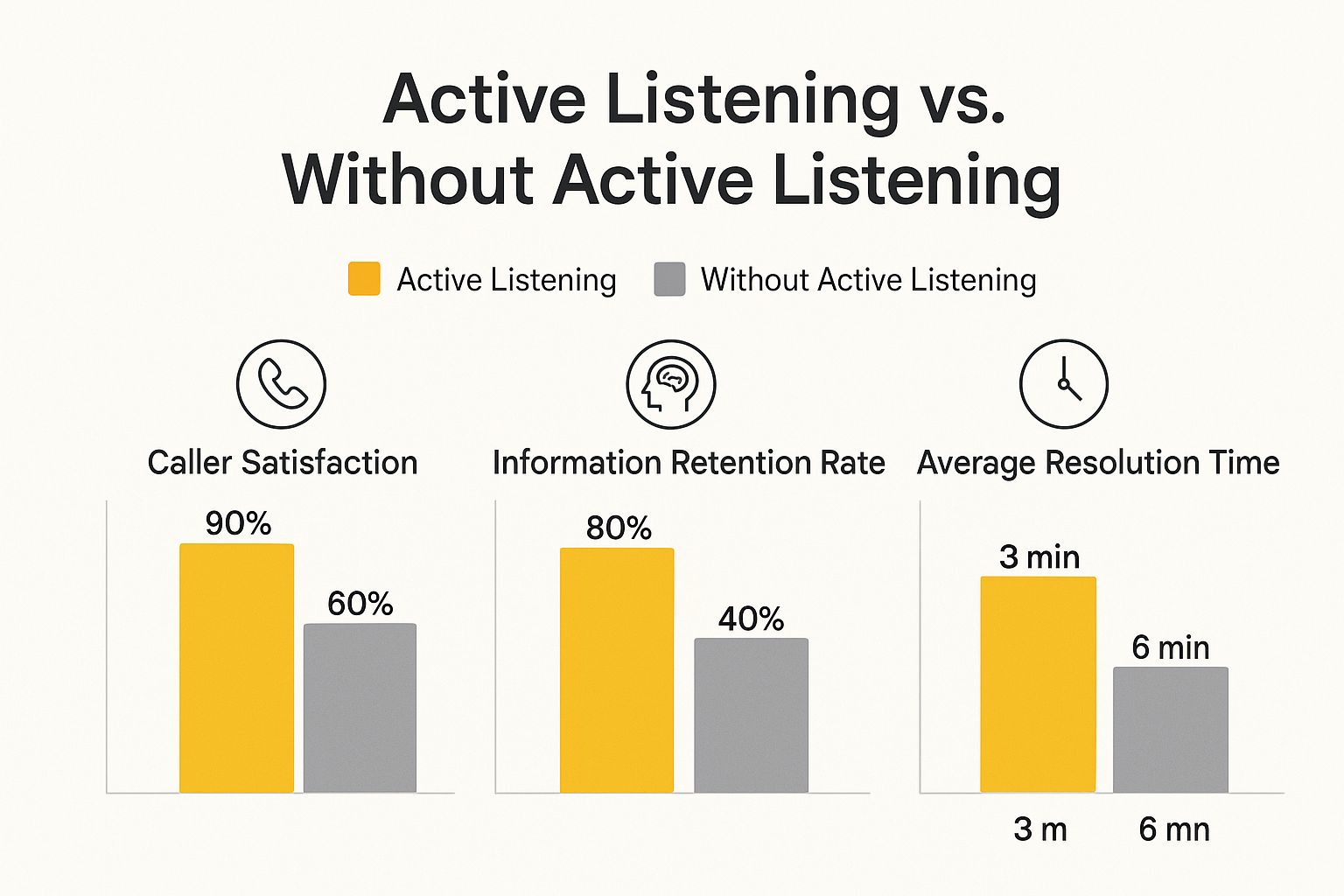Making Every First Impression Count

Those first few seconds of a phone call? They're everything. Seriously, they set the tone for the whole conversation. I've chatted with loads of customer service pros across Australia, and you know what’s funny? Those robotic greetings like "Thank you for calling…" often miss the mark. They just don't feel genuine.
Think about how you answer your own phone. Do you use a stiff, formal script? Doubt it. You're probably relaxed and friendly. That personal touch is what many business calls are missing. Ditch the generic greeting. Instead, try something like, "Good morning, this is [Your Name/Company Name], how can I help you?" Simple, right? But it makes a world of difference.
This whole idea of authentic communication is becoming super important, especially with everyone using smartphones for business these days. It’s changing how customers interact with companies. Look at the number of smartphone users in Australia. It's expected to hit 23.6 million by 2026, up from 19.9 million in 2017. That means more calls and messages than ever. Having a good system for answering the phone isn't just a nice-to-have; it's a must-have. Discover more insights on smartphone usage in Australia.
The Power of Tone
Let's talk about your voice. It's a powerful tool. It can show confidence, empathy, or even frustration, all in just a few words. Imagine calling a business and getting someone rushed and monotone. Not a great experience.
But a warm, friendly tone? That puts you at ease. It's like the difference between a quick handshake and a real hug. This doesn’t mean putting on a fake voice. It means bringing your natural energy to the call.
Tailoring Your Greeting
One size doesn’t fit all with phone greetings. You wouldn’t greet a close friend the same way you'd greet a new client, right? Your phone greeting should be the same way. For internal calls, a quick "Hi, this is [Your Name]" is probably fine. But for external calls, especially new clients, a more formal "Good morning, [Company Name], this is [Your Name], how can I assist you today?" is more professional. These little tweaks can significantly impact how callers see your business. Be mindful of your tone and tailor your greeting. It helps create positive first impressions, builds trust, and sets you up for successful conversations. And that’s the goal – every call a win-win.
Finding Your Professional Phone Voice
I've been in this business a while now, and one thing I’ve learned is this: your in-person voice and your phone voice are two completely different beasts. After listening to hundreds of call recordings, the contrast between a voice that builds trust and one that, well, doesn't, is truly remarkable. Let's talk about how to nail that perfect phone voice.
The Speed Trap
Have you ever noticed how some people on the phone just talk a mile a minute? They think they're being efficient, but it actually has the opposite effect. Speaking too fast makes you harder to understand, which leads to the other person asking you to repeat yourself…and that’s just frustrating for everyone. Think of it like overpacking a suitcase – you just end up wasting time unpacking everything to find what you need. Slowing down, even a little, makes a world of difference.
The Power of the Pause
Something else that’s super important? Strategic pauses. A well-placed pause gives you a moment to collect your thoughts, emphasize a key point, and even de-escalate a tense situation. It also allows the caller to process what you’re saying and feel more in control, especially if they're dealing with a complex issue. It's like adding punctuation to your sentences – commas and periods give your words clarity and punch.
Projecting Confidence
Projecting confidence – not arrogance, there's a big difference – comes through in how you speak. A voice coach I know who works with customer service teams always talks about the importance of "vocal presence.” It's not about faking it, it’s about using your natural voice in a powerful way. For more tips on this, check out this helpful guide: How to answer the telephone.
Practical Exercises
Developing a strong phone presence definitely takes practice. One easy exercise? Record yourself answering the phone in various scenarios. Then, listen back. Are you clear? Concise? Do you sound confident and helpful? This self-assessment is pure gold. Another technique I recommend is reading aloud, focusing on your pace and how your voice rises and falls. Think of it as a workout for your voice – the more you use it, the stronger it gets.
To help illustrate the impact of your voice, take a look at this table:
Voice Characteristics and Their Impact on Caller Perception
This table breaks down how different vocal qualities can affect your professional phone calls.
| Voice Quality | Caller Perception | Business Impact | Improvement Tips |
|---|---|---|---|
| Fast/Rushed | Impatient, disorganized | Missed information, frustrated callers | Slow down, breathe, enunciate |
| Monotone | Bored, disengaged | Lack of interest, decreased credibility | Vary pitch and tone, express enthusiasm |
| Mumbling/Soft | Unsure, unprofessional | Difficulty understanding, requests for repetition | Speak clearly, project your voice, enunciate |
| Clear and Confident | Professional, knowledgeable | Builds trust, positive interactions | Practice clear speech, maintain consistent tone |
| Hesitant/Uncertain | Lack of expertise, untrustworthy | Decreased confidence in your abilities | Prepare answers, practice responses |
As you can see, even small changes in your voice can have a big impact.
Maintaining Consistency
Let’s be honest, keeping a professional tone on your twentieth difficult call of the day can be challenging. Especially when you're tired or stressed. But maintaining that consistent tone, no matter what, is the mark of a true pro. Having a few go-to phrases or mental strategies can help you reset and refocus when things get tough. It's like having a toolkit ready for any situation. Remember, a strong phone voice isn't just about sounding good; it’s about making a positive impression, building rapport, and getting the job done.
Thriving During Peak Call Chaos

We've all been there. Phones ringing non-stop, feeling like you're the only one holding back the flood. It's a real juggling act. But it's in these high-pressure moments that the pros truly stand out. They manage to maintain quality even when the sheer volume of calls feels overwhelming.
The secret? Don't rush. I've learned this the hard way – and heard it echoed by countless call center veterans – trying to speed through calls often backfires and creates more work. When you're rushing, you miss things. Important things. And missed details lead to misunderstandings and callbacks. It's not just about personal efficiency either. Effective call centers are crucial for good customer service, especially in Australia. Recent reports highlight the difficulties even large call centers face managing high call volumes. For more info, check out this article on call center hold times in Australia: Call Centre Hold Times in Australia.
Staying Calm Under Pressure
So, how do you stay cool and collected when the phone just won't quit? Mental strategies are key. I personally visualize each call as a fresh start. It helps clear my head, even after a difficult caller. Another quick tip? Deep breaths between calls. It sounds too simple, but trust me, those few seconds make a world of difference in managing stress.
Managing Multiple Calls Effectively
Then there's the whole juggling multiple calls thing. Hold times are sometimes unavoidable, especially during peak periods, but managing them well is crucial. Clear communication is your best friend. Tell callers you'll be putting them on hold briefly and thank them for their patience when you return. A quick explanation makes them feel valued. And tools like OnSilent's smart voicemail are game-changers. Callers can leave a detailed message if they can't wait, and you can follow up efficiently later.
Avoiding Burnout
Lastly, let's talk burnout. It's a real risk in high-volume call environments. Knowing the warning signs – like getting easily irritated or struggling to focus – is important. Take short breaks, even just a couple of minutes away from the phone. It helps prevent burnout. Remember, you can’t help others if you’re running on empty. Self-care is essential for providing excellent service. By using these strategies, you can not only survive peak call chaos but thrive. Turn potentially stressful situations into opportunities to show your professionalism and build stronger customer relationships.
Turning Tough Calls Into Professional Wins

The infographic above shows just how much of a difference active listening makes during calls. Compare caller satisfaction, how much info they actually remember, and the average time it takes to resolve their issue – with and without active listening. The results are pretty striking. Active listening boosts caller satisfaction (90% vs. 60%), improves information retention (80% vs. 40%), and cuts resolution time in half (3 minutes vs. 6 minutes). This isn't just about ticking boxes; it's about happier customers and more efficient use of your time.
Let's be real, not every call is a walk in the park. It’s the tough ones that really put your phone skills to the test. We've all been there – a frustrated caller on the line, and your instinct is to jump in and fix it right now. But experience (and lots of conversations with customer service pros) has taught me that this can often do more harm than good.
De-escalation: The Power of Strategic Silence
Here’s a secret weapon for those tricky calls: silence. I know, it sounds strange. But giving the caller a moment to vent (unless things get abusive, obviously) can be surprisingly effective. Letting them express their frustration often makes them more open to solutions later. For example, if someone’s upset about a late delivery, resist the urge to immediately explain. Let them finish, acknowledge their feelings ("I understand this is frustrating"), and then offer solutions.
Mastering the Language of De-escalation
The words you use make a huge difference, especially in tense situations. Phrases like "I understand," "Let's see what we can do," and "I'll find out for you" are incredibly valuable. They show the caller you're listening and willing to help, shifting the conversation from confrontation to teamwork. Just as important? Avoiding accusatory language or interrupting, even if you think the caller is mistaken. This is crucial for de-escalation. You might find some helpful tips in this article on Call Handling Best Practices.
Reading Between the Lines
Learning to interpret vocal cues is a game-changer. A seasoned call handler can tell the difference between genuine anger and underlying anxiety just by listening to the caller's tone and how fast they’re speaking. A rapid-fire, interrupting caller might be anxious, while someone speaking slowly and deliberately might be resigned or frustrated. Understanding these nuances helps you tailor your approach.
Protecting Your Own Well-being
Finally, remember to look after yourself. Dealing with difficult callers day after day can be draining. Knowing when to escalate a call to a supervisor is just as important as knowing how to answer the phone professionally. Don't hesitate to ask for support. Taking a short break after a particularly challenging call can make a world of difference. Your well-being is key to providing excellent service in the long run.
Here's a handy table summarizing some common tricky call situations and how to handle them:
Common Difficult Call Scenarios and Response Strategies
Practical approaches for handling challenging phone conversations professionally
| Scenario Type | Initial Response | De-escalation Technique | Resolution Approach |
|---|---|---|---|
| Angry Customer | "I understand you're frustrated…" | Active listening, validating feelings | Offer solutions, apologize if appropriate |
| Confused Customer | "Let me clarify that for you…" | Patience, clear explanations | Provide step-by-step instructions |
| Demanding Customer | "I'll see what I can do…" | Set clear expectations | Negotiate a reasonable solution |
| Anxious Customer | "I'm here to help…" | Reassurance, calm tone | Provide clear and concise information |
| Talkative Customer | "I appreciate the information, now let's focus on…" | Polite interruptions | Gently steer the conversation back to the main issue |
This table provides a quick reference for navigating challenging conversations. Remember, every situation is unique, but these strategies can help you stay professional and find positive resolutions.
Creating Real Connections Through Voice Alone
The best electricians, plumbers, or anyone who works with clients over the phone, know something crucial: every call is a chance to connect, not just take an order or book a job. It’s about building rapport, even when you'll never meet face-to-face. How do you do that? By truly listening and adding a personal touch.
I've seen this firsthand. A while back, I had a persistent internet issue. The tech support person I spoke with didn't just go through the motions. They actually listened to my frustration, acknowledged the inconvenience, and even chuckled with me about how reliant we are on Wi-Fi these days. That little bit of empathy made all the difference.
Listening Beyond the Words
Think about the customer service interactions you've loved. Chances are, the person on the other end made you feel heard. They picked up on the emotion behind the words. Someone calling about a delayed delivery might be worried about missing a deadline, not just the package itself. Understanding that unspoken concern lets you address the real issue.
I once called my bank about a charge I didn't recognize. The representative immediately grasped my underlying worry – not just about the money, but about the possibility of identity theft. Addressing that concern head-on made me feel so much more secure.
The Personal Touch: Small Details, Big Impact
Remember details from past conversations. I once called a software company and the support agent remembered we'd spoken months earlier about a completely different issue. It transformed the interaction from transactional to personal. It made me feel like a valued customer, not just a ticket number.
These seemingly small things are powerful. A simple "I remember you mentioned you were working on a big project last time we spoke. How's that going?" can create a real connection.
Adapting Your Style: One Size Doesn't Fit All
Just like in person, everyone communicates differently on the phone. Some are chatty, others to the point. Adjust your style to match the caller. This isn’t about mirroring their every word, but finding a comfortable rhythm. If a caller is clearly upset, matching their energy with rapid-fire speech might escalate things. A calmer, slower pace can help de-escalate.
Building Trust in Seconds
Building trust, especially with a frustrated caller, is key. Be upfront. If you don't have an immediate answer, say so. Offer to find out and get back to them. Don't over-promise. Under-promise and over-deliver. This shows you're genuinely invested in helping. It's about turning a potentially negative interaction into a positive one. And that’s how you build lasting relationships, one call at a time.
Mastering Phone Culture in Modern Australia

Answering a business call well in Australia isn't just about saying "hello." It's about getting the vibe right – understanding what makes Aussie communication tick. This is especially important in a country as diverse as ours. Let's dive into how to make your phone skills really resonate with modern Australian callers.
Regional Variations: From City to Outback
Australia's communication styles are as varied as its landscapes. Think about the fast-paced buzz of Sydney compared to the more relaxed feel of a regional town. Take Perth, for example. They're known for being friendly and direct. Businesses there value efficiency and building quick rapport, even over the phone. Contrast that with Darwin, where a more relaxed, chatty approach might be better received.
Knowing these regional differences can seriously affect how you connect with callers. Imagine you're in Melbourne and get a call from rural Queensland. Taking a moment for a quick, non-business chat can build trust and show you respect their pace of life.
The Rise of the Mobile-First Culture
Australians and their mobiles are inseparable. This "mobile-first" way of life has totally changed how customers interact with businesses. People expect quick answers and easy ways to get in touch. Services like OnSilent with its smart voicemail and call management features can help manage this. It's all about providing top-notch service, even when things are hectic. For more tips on Australian phone etiquette, check out this helpful guide.
Speaking of mobiles, did you know Australia has 34.4 million active mobile connections? That's 128% of the population! (Check out these SMS marketing statistics and mobile usage stats.) Many Aussies juggle multiple devices. So, when that phone rings, a fast, helpful response is gold.
Adapting to Modern Business Practices
Successful Aussie businesses get this. They're adapting their phone strategies to meet these new expectations. Think about how often you use your phone to contact businesses. It's probably your main way, right? That’s why businesses need to be on top of their phone game.
I recently saw this in action with a small plumbing business in Brisbane. They use OnSilent to streamline their communication, prioritize callbacks, and manage their packed schedules. Just by making sure every call is handled, they've seen a real improvement in customer satisfaction.
Key Takeaways
So, how do you nail those business calls and make every interaction count? Let's recap the core strategies we've talked about, turning them into a practical playbook you can use right away.
First Impressions Are Everything
The first few seconds of a call are like a handshake – they set the tone. Forget robotic greetings. Instead, inject some genuine warmth. A simple "Good morning, [Your Name/Company Name], how can I help you?" works like a charm. Your tone is the foundation of the entire conversation.
Discover Your Professional Phone Voice
Believe it or not, your phone voice isn't the same as your everyday voice. Slow down, speak clearly, and use pauses to highlight important points. Projecting confidence and keeping a steady tone, even during stressful calls, builds trust and leaves a great impression. Record yourself and listen back – you'll be surprised what you learn! Focus on any areas you could improve.
Conquer Call Overload
When the phone's ringing off the hook, staying calm and organized is your superpower. Don't rush. Prioritize calls, use hold times strategically, and communicate clearly with everyone. Take short breaks to avoid burnout – a fresh mind handles calls better. Tools like OnSilent's smart voicemail can be incredibly helpful, allowing callers to leave detailed messages when you're unavailable.
Turn Tricky Calls into Opportunities
Difficult calls are part of the game. Instead of jumping into problem-solving mode immediately, listen carefully and let the caller express their concerns (within reason, of course). Use de-escalation techniques, acknowledge their feelings, and offer helpful solutions. Empathy and well-placed silence are your secret weapons in these situations.
Build Genuine Connections
Every call is a chance to build rapport. Listen actively, understand what the caller truly needs, and personalize the interaction whenever possible. Remember details from previous conversations – it shows you care. Adjust your communication style to match the caller's personality and preferences.
Navigate Australian Phone Etiquette
Australia has its own distinct communication style. Be aware of regional differences and adapt your approach. Embrace the mobile-first culture by providing quick and efficient service. Tools like OnSilent can help you manage your calls and messages effectively.
Ready to take your phone game to the next level and save valuable time? Explore OnSilent's features and see how it can improve your communication.

